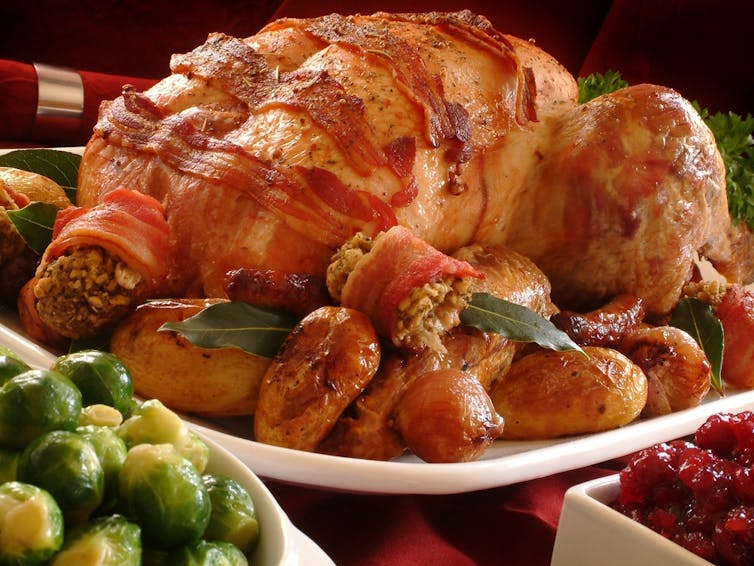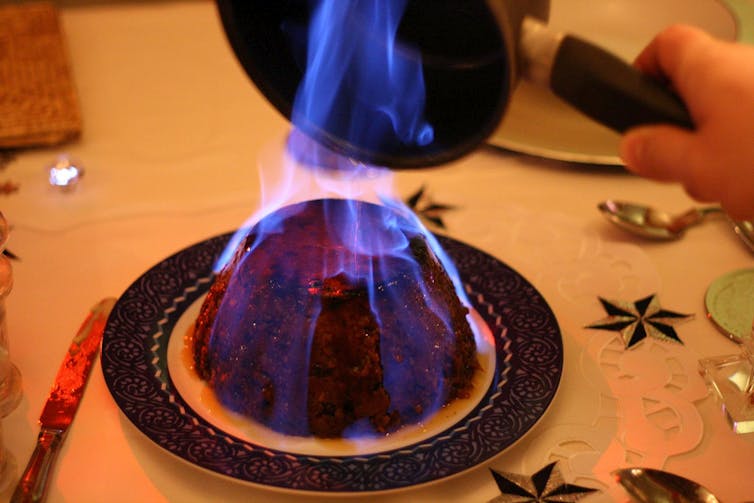From the enticing aroma of the turkey in the oven to the “whoosh’” of the flames as the brandy-soaked pudding comes alight, Christmas is a wonderful time for the senses. But have you ever considered the science behind our best-loved festive traditions? Here are seven of my food and flammable favourites:
Candle light, shining bright

Candle-lit carol services are part of Christmas for many people, as are the ones entwined in holly on the table. Traditionally beeswax was used but while it gives great flames, it is rather expensive. Nowadays the vast majority of candles are made of paraffin wax obtained as one of the products of oil refining. These waxes are hydrocarbons, molecules made of two different elements: carbon and hydrogen.
When you light a candle, wax is melted, and the molten wax gets drawn up the wick, which gives a larger area for the wax to evaporate. It is the gaseous wax that burns, forming carbon dioxide and water, and giving out energy, which is where the heat and light come from.
But not all the carbon atoms get turned into carbon dioxide at one go – it is carbon-rich soot particles glowing hot that give out the yellow light that characterises a candle flame.
Turkey time

Most people know that cooking involves chemistry, and where better to start than the Christmas Day turkey? The turkey meat you cook is muscle tissue, about 20% of which is protein (nearly all the rest is water), with a small but important amount of carbohydrate. If you “hang” the meat and allow it to age, enzyme catalysts naturally present in the muscle start to break down the proteins so that they lose their naturally rigid structure and the meat becomes more tender.
You can speed up the tenderising process by heating the meat, but above a certain temperature the enzymes stop working. This is why many chefs cook the turkey for a long time at a low temperature – if they just stuck it in a hot oven, the protein chains would tend to bunch together, which, coupled with the loss of water, results in tough and dry meat.
Simply cooking the meat at low temperatures wouldn’t give the meat its brown colour and the wonderful smell and taste that go with roast turkey. This is down to a chemical reaction known as the Maillard reaction, which kicks in above 140°C. It’s named after the discoverer, Louis Camille Maillard (that’s Maillard, not mallard, which would be a duck, not a turkey).
Roast potatoes are cooked at a higher temperature than boiled potatoes – and traditionally in animal fat too – which allows Maillard reactions to occur, generating the smell and also the browning.
Bitter sprouts: in the genes?

Around 40% of Brussels sprouts produced for the UK market are eaten in the weeks leading up to Christmas. And if you’re one of those people who find Brussels sprouts bitter, there may well be a genetic reason for it. In 2006, scientists found that the presence of the TAS2R38 gene leads to a receptor that comes up with the “bitter” response when tasting Brussels sprouts and others in the brassica family. This bitter taste is down to compounds called glucosinolates, such as sinigrin, which are there for a reason: they help plants including Brussels sprouts, horseradish and mustard fend off insect predators.
It’s not all bad, though, as scientists have also found that the glucosinolates in sprouts break down to give a molecule called sulforaphane, which has promise in fighting some cancers. So eat up those greens.
Oranges aren’t the only fruit

Oranges are traditionally eaten at Christmas. The smell of orange peel comes from very small amounts of aldehydes, including the eight-carbon molecule octanal, which is slightly smaller than its brother aldehydes used to impart that amazing aroma to perfumes such as Chanel No 5.
More than 90% of the oil you get from the peel is made up of the hydrocarbon limonene, found in lots of other fruits such as lemons and grapefruit. Because it’s a hydrocarbon – slightly larger than the hydrocarbon molecules that make up petrol – it is rather flammable, so don’t try squirting your orange oil at the candles on the table.
Pudding a la flambé

The more obviously flammable part of the Christmas meal is the Christmas pudding. Brandy is normally used to provide the fuel: ethanol. The ethanol molecule contains some oxygen, so it burns with a clear, hot, blue flame, unlike the hydrocarbons in candle wax, which give a yellow flame.
Over half the brandy is actually water, so some of the heat from the fire is used to evaporate the water, which stops the pudding from getting too hot and burning to a crisp, so it keeps that moist, chewable consistency.
Crackers, but not for the faint-hearted

And what about the crackers you pull at the meal? How do they work? Some crackers use a chemical called silver fulminate. It is a very shock-sensitive substance, a cousin of chemicals such as lead azide, used in detonators.
As you know, a cracker contains two long, narrow strips of card. One is painted with a tiny amount of silver fulminate, while the other is coated with an abrasive – a sandpaper-like material. They are in contact with each other so that when the cracker is pulled, the two strips of card slide past each other and the friction from the abrasive detonates the silver fulminate. There is only a tiny amount – micrograms – of the silver fulminate: any more and the “crack” would be a “kaboom!”
Do try this at home

Christmas trees are very flammable, for the same reasons that forest fires can spread quickly. One of the culprits is a molecule called pinene. As you’d guess from its name, it’s found in pine trees and contributes to their special smell.
While it goes without saying that playing with fire should come with extra precautions, here’s something involving pine cones you can try at home and which will put a bit of colour into your Christmas. Make up solutions of different salts dissolved in water, such as copper sulphate solution (used to kill algae and available to buy online) or sodium chloride (common salt) solution. Soak the pine cones in one of these solutions overnight, then take them out and let them dry out. When you put them on top of a coal fire, they’ll burn with a coloured flame: yellow for common salt, turquoise for copper sulphate – a taste of the chemistry-related magic of Christmas.

